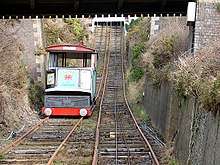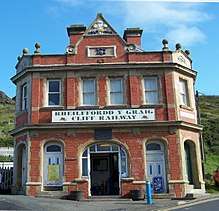Aberystwyth Cliff Railway
| Aberystwyth Cliff Railway | |
|---|---|
|
| |
| Overview | |
| Locale | Aberystwyth |
| Transit type | Funicular railway |
| Number of stations | 2 |
| Operation | |
| Began operation | 1 August 1896 |
| Operator(s) | Constitution Hill Ltd |
| Technical | |
| System length | 778 feet (237 m) |
| Track gauge | 4 ft 10 in (1,473 mm) |
The Aberystwyth Cliff Railway (Welsh: Rheilffordd y Graig) opened on 1 August 1896. It is a funicular railway in Aberystwyth, Ceredigion, Wales, having a length of 778 feet (237 m). It was the longest funicular railway in the British Isles[1] until 2001, when the Cairngorm Mountain Railway opened. Since November 1987, the Aberystwyth Cliff Railway has been a Grade II listed structure.
The funicular railway is a cable-drawn balanced system, using a pair of passenger cars connected together via a continuous cable that run in opposite directions along separate parallel tracks. It was developed as an element of Constitution Hill, a Victorian business venture by the Aberystwyth Improvement Company in the 1890s. The funicular allowed access to the top of the hill, where attraction such as a camera obscura were established. The cliff railway was operated using a water balance system but during 1921, it was electrified and the water-based system was dismantled. Passengers numbers were high during its initial decades, but dipped after the outbreak of the Second World War and stayed depressed for decades. The cliff railway is owned and run by Constitution Hill Ltd, a registered charity. It is open to passengers during the summer months, typically operating between April and October, with a reduced timetable during the colder months.
Location
The Aberystwyth Cliff Railway was part of the Constitution Hill development built by the Aberystwyth Improvement Company, which was established in 1895.[2] It was an early theme park, consisting of arcades and restaurant at the foot of the hill, and a camera obscura and park at the top. The funicular railway was developed to transport people between the areas.[3] Constitution Hill was designed and engineered by George Croydon Marks who at the same time designed the pavilion for the Royal Pier.[4] Croydon-Marks also designed a meandering footpath as an alternative route to the Cliff Railway. In order to allow it to pass over the railway, around 12,000 tonnes of rock was excavated for the middle section of the footpath to accommodate a footbridge. The area is surrounded by the gardens and pleasure grounds that comprise Constitution Hill.[2]
Design

The cliff railway is cable-drawn balanced system, moving a pair of cars, holding a maximum capacity of 30 passengers, permanently connected via a continuous cable that run in opposite directions along separate parallel tracks.[2] When opened, it operated using a water balance system, which used a Worthington Corporation compound steam engine water pump housed in the lower station to move water to the upper station. Each passenger car had a tank containing up to 4 tonnes of water incorporated into their chassis frames. Movement was achieved by adding water to the tank of the top car, which induced its descent under gravity and brought the lower car, which was lighter, up the slope to the top station.[2]
The cliff railway runs a straight course, ascending some 430 feet (130 m) within the space of 778 feet (237 m), resulting in a gradient steeper than 1:2 (50 per cent).[2] The gradient is not consistent along the length of the tracks as the slope varies in steepness towards each end, a measure that helps with acceleration and deceleration. The rails are spaced wider than on a standard gauge railway, at 1.473m (4ft 10in), and laid on timber sleepers.[2]
The cliff railway was electrified using a 41kW Morley DC motor in 1921 and the water balance system was discontinued on grounds of cost.[2] In 1934 after changes to the town’s electricity supply, a mercury arc rectifier and transformer were installed in the lower station to provide a 440V DC power output. Since the cliff railway's conversion to electrical motive power, the cars are moved via a high-tensile steel cable attached to both vehicles. It passes around a drum, mounted on a vertical axis, in a central position between the tracks near the top.[2] The motor acts on the drum, moving it in one direction or the other dependent on which of the cars is at the bottom. Safe control of the system is by an automated cut-off which stops the motor and the cars when required.[2]
Operations


The cliff railway opened to the public in 1896; and was credited with stimulating the development of Constitution Hill as a popular leisure area.[5]
Throughout the 1920s and 1930s, the cliff railway was popular with visitors but during and after the Second World War, passenger numbers declined significantly.[2] In 1948, seeking to revive its fortunes, the Aberystwyth Pier Company bought it and carried out repairs and upgrades. The new owner were unable to make a positive impact on passenger numbers.[2] Its twin carriages[2] are named Lord Geraint and Lord Marks.
In 1976, the railway was closed briefly on account of a fault in its braking system.[2] During the late 1970s, a local mining company acquired a majority stake and formed the Aberystwyth Cliff Railway Company to operate it. In 1978 a new electrical system was installed which is used to the present day. It takes its power from and returns surplus energy to the National Grid.[2]
In November 1987, the cliff railway was recognised as a Grade II listed structure.[2] In 1998, it was purchased by Constitution Hill Ltd,[5] a registered charity, the trustees are volunteers; all profits generated support the railway's maintenance and restoration activities. The cliff railway has received some external funding, including grants from European Union funds.[5]
The railway is operated under a light railway order.[2] The line is open to passengers during the summer months, typically operating between April and October, while transitioning to a limited timetable during the colder months.[6]
The upper station was refurbished with a café and gift shop during 2005 and roof repairs were made in 2014.[2] Ramps and other adaptations make the service accessible to wheelchair users. The ticket office at the lower station has been converted into a holiday apartment; guests can ride the cliff railway for free.[7] Of the four original timber bridges constructed to carry hillside paths over the railway, three remain at the northern half of the route for foot traffic.[2]
Appearance in music and literature
The railway makes appearances in the work of author Malcolm Pryce.[8]
See also
References
- ↑ Riley, Andrew; Blackwood, Lorna (30 November 2007). "Focus on... Aberystwyth". London: The Times. Retrieved 4 June 2010.
- 1 2 3 4 5 6 7 8 9 10 11 12 13 14 15 16 17 18 "Aberystwyth Cliff Railway". engineering-timelines.com. Archived from the original on 23 February 2012. Retrieved 4 June 2010.
- ↑ "Aberystwyth Cliff Railway." stallionvalley.com, Retrieved: 22 June 2018.
- ↑ "Aberystwyth Royal Pier". visitaberystwyth.com. Archived from the original on 3 November 2013. Retrieved 31 May 2010.
- 1 2 3 "Aberystwyth Cliff Railway." historypoints.org, Retrieved: 22 June 2018.
- ↑ "Aberystwyth Cliff Railway." visitmidwales.co.uk, Retrieved: 22 June 2018.
- ↑ Hutchinson, John."The train station you'll WANT to be delayed at: Ticket office transformed into a beautiful cottage with stunning sea views (and guests even get free rail rides along the cliffs)." Daily Mail, 1 January 2016.
- ↑ Katsoulis, Melissa. "Something fishy in Wales." The Telegraph, 7 May 2005.
External links
| Wikimedia Commons has media related to Aberystwyth Cliff Railway. |
- Constitution Hill
- Map sources for Aberystwyth Cliff Railway